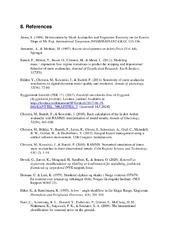| dc.contributor.advisor | Vick, Louise | |
| dc.contributor.advisor | D'Amboise, Christopher | |
| dc.contributor.author | Hansen, Vilde Edvardsen | |
| dc.date.accessioned | 2024-07-10T06:45:37Z | |
| dc.date.available | 2024-07-10T06:45:37Z | |
| dc.date.issued | 2024-05-30 | |
| dc.description.abstract | Slushflows are defined as rapid mass movement and occur when water-saturated snow (slush), rapidly moves downslope as a flowlike process. The high-water content of the flow results in high density and mobility flow that poses a significant danger to everything in its path. To predict how slushflows navigates the terrain, numerical modelling is a valuable tool. The output of the simulations would provide valuable information for spatial planning, construction of mitigation measures and for identifying areas that requires early warning.
A gravitational mass runout simulation tool used for hazard assessments of the slushflow danger is RAMMS:Debrisflow. To calibrate the model to simulate slushflow runouts with statistic confident, an already established parameter was attempted validated. To be able to extent the dataset and back-calculate slushflow events, they need to be well documented. Four events from three field sites occurring winter/spring 2023 in Northern Norway, were digitised based of field observations.
The calibrated parameters would generally represent the slushflow runout for starting conditions in slopes over 10° angle. Because of assumption in the model, it is not possible to replicate starting conditions in gentler slope. This limitation excludes slushflows traveling over low slope gradient terrain from this method, and a method for assessing this hazard must be developed. However, for other events the shortcoming can be overcome by defining the release area in steeper part of the slushflow path. The uncertainties related to this solution investigated by analysing the sensitivity of defining these release areas (location and volume). These input variables were too sensitive to truly test the capability of RAMMS:Debrisflow to simulate slushflows, and guidelines must be created to standardise the method to define these release areas. | en_US |
| dc.identifier.uri | https://hdl.handle.net/10037/34140 | |
| dc.language.iso | eng | en_US |
| dc.publisher | UiT Norges arktiske universitet | en_US |
| dc.publisher | UiT The Arctic University of Norway | en_US |
| dc.rights.accessRights | openAccess | en_US |
| dc.rights.holder | Copyright 2024 The Author(s) | |
| dc.rights.uri | https://creativecommons.org/licenses/by-nc-sa/4.0 | en_US |
| dc.rights | Attribution-NonCommercial-ShareAlike 4.0 International (CC BY-NC-SA 4.0) | en_US |
| dc.subject.courseID | GEO-3900 | |
| dc.subject | Slushflow | en_US |
| dc.subject | Numerical modelling | en_US |
| dc.title | Investigating limitations of RAMMS:Debrisflow as a slushflow simulation tool: Using numerical modelling as a tool to predict slushflow runouts | en_US |
| dc.type | Master thesis | en_US |
| dc.type | Mastergradsoppgave | en_US |


 English
English norsk
norsk

